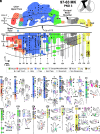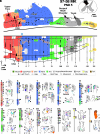Cortical reorganization following dorsal spinal injuries in newborn monkeys reveals a critical period in the development of the somatosensory cortex
- PMID: 39835892
- PMCID: PMC11789031
- DOI: 10.1073/pnas.2417417122
Cortical reorganization following dorsal spinal injuries in newborn monkeys reveals a critical period in the development of the somatosensory cortex
Abstract
Lesions of the dorsal columns of the spinal cord in adult macaque monkeys lead to the loss of hand inputs and large-scale expansion of the face inputs in the hand region of the somatosensory cortex. Inputs from alternate spinal pathways do not reactivate the deafferented regions of area 3b. Here, we determined how transections of the dorsal columns done within a few days after birth affect the developing somatosensory cortex. Dorsal columns were transected between the 3rd and 12th postnatal day (PND), and the somatosensory cortex was mapped when the macaques were over 3 y old. There were two distinct outcomes depending on the age at the time of the lesion. In monkeys lesioned between the 3rd and 5th PND, neurons in the entire hand region of area 3b and the adjacent somatosensory cortex responded to touch on the hand. An alternate spinal pathway must have replaced the lost pathway. In monkeys lesioned between the 9th and 12th PND, neurons in the deafferented hand region did not respond to touch on the hand. There was medialward expansion of the face representation into the deafferented cortex and a lateral expansion of the arm representation as in lesioned adults. Thus, different mechanisms underlie the reorganization of area 3b and the adjacent somatosensory cortex following identical spinal cord injuries sustained as early or late newborns. The results suggest that alternate spinal cord pathways can develop within a critical period before the 9th PND, but not later.
Keywords: Macaca; area 3b; brain plasticity.
Conflict of interest statement
Competing interests statement:The authors declare no competing interest.
Figures





Similar articles
-
Intracortical and Thalamocortical Connections of the Hand and Face Representations in Somatosensory Area 3b of Macaque Monkeys and Effects of Chronic Spinal Cord Injuries.J Neurosci. 2015 Sep 30;35(39):13475-86. doi: 10.1523/JNEUROSCI.2069-15.2015. J Neurosci. 2015. PMID: 26424892 Free PMC article.
-
Altered Expression of Reorganized Inputs as They Ascend From the Cuneate Nucleus to Cortical Area 3b in Monkeys With Long-Term Spinal Cord Injuries.Cereb Cortex. 2018 Nov 1;28(11):3922-3938. doi: 10.1093/cercor/bhx256. Cereb Cortex. 2018. PMID: 29045569
-
Large-scale reorganization of the somatosensory cortex following spinal cord injuries is due to brainstem plasticity.Nat Commun. 2014 Apr 8;5:3602. doi: 10.1038/ncomms4602. Nat Commun. 2014. PMID: 24710038
-
The Black Book of Psychotropic Dosing and Monitoring.Psychopharmacol Bull. 2024 Jul 8;54(3):8-59. Psychopharmacol Bull. 2024. PMID: 38993656 Free PMC article. Review.
-
Use of endoanal ultrasound for reducing the risk of complications related to anal sphincter injury after vaginal birth.Cochrane Database Syst Rev. 2015 Oct 29;2015(10):CD010826. doi: 10.1002/14651858.CD010826.pub2. Cochrane Database Syst Rev. 2015. PMID: 26513224 Free PMC article.
References
-
- Hubel D. H., Wiesel T. N., LeVay S., Plasticity of ocular dominance columns in monkey striate cortex. Philos. Trans. R. Soc. Lond. B Biol. Sci. 278, 377–409 (1977). - PubMed
-
- Takahata T., Patel N. B., Balaram P., Chino Y. M., Kaas J. H., Long-term histological changes in the macaque primary visual cortex and the lateral geniculate nucleus after monocular deprivation produced by early restricted retinal lesions and diffuser induced form deprivation. J. Comp. Neurol. 526, 2955–2972 (2018). - PMC - PubMed
-
- Warner C. E., et al. , Preservation of vision by the pulvinar following early-life primary visual cortex lesions. Curr. Biol. 25, 424–434 (2015). - PubMed
-
- Chino Y. M., Kaas J. H., Smith E. L. III, Langston A. L., Cheng H., Rapid reorganization of cortical maps in adult cats following restricted deafferentation in retina. Vision Res. 32, 789–796 (1992). - PubMed
-
- Schwaber M. K., Garraghty P. E., Kaas J. H., Neuroplasticity of the adult primate auditory cortex following cochlear hearing loss. Am. J. Otol. 14, 252–258 (1993). - PubMed
MeSH terms
Grants and funding
LinkOut - more resources
Full Text Sources
Medical

